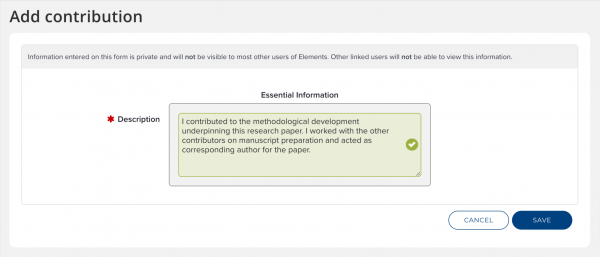Find out more about our products or services and to request a free no obligation demo
Get in touchAs most Elements users will be aware, we have used the CRediT taxonomy within Elements since 2018 to help simplify the capture of contributions undertaken by authors linked to a publication. However, the adoption of the CRediT taxonomy within Elements was only a stepping stone towards allowing Elements users to better describe their personal contribution to their outputs and activities.
In this release we have made a major extension to our data model, introducing Object Annotations to help researchers more readily capture information on their contribution to research items within Elements, such as publications, grants, or non-standard outputs. By making it possible for researchers to showcase the full range of their contributions, we can help researchers get credit for all their work by ensuring they have the data they need when the time comes for reporting, assessment or promotion processes, as well as research-promoting activities such as press and public engagement.

In our last release, we announced a significant redesign of the Assessment module researcher user experience. In this release, we have continued to build on this work to further streamline review and assessment workflows with our new simplified submission process which will automatically progress each form to the next stage. New configuration options make the powerful ‘stages’ functionality even more flexible, granting institutional administrators more fine-grained control over actions, along with configurable guidance text to signpost users through the process with clarity.
We have expanded our Data Extracts functionality to make it possible to generate extracts in an XML format. This functionality has been specifically developed with our Canadian clients in mind, to help support the export of data from Elements for researchers to more easily populate their Canadian Commons CV (CCV). This means that your researchers can reuse data already captured and curated within Elements, reducing the need for repeated data entry.
To support researchers and institutions who are making works openly available via an integrated repository and to ensure that they are including clear information on how they can be used, we have introduced new reuse licence configuration options to encourage or even mandate the use of reuse licences during the deposit process.
Finally, we have continued to grow our dedicated Research Funding Solution (RFS), with ongoing development to allow organisations to integrate RFS with in-house finance systems in order to enable easier project set-up.
For all details about the release, you can view the full release notes on the Symplectic support site. As always, the new version of Elements and associated upgrade instructions can be found in the Elements upgrade forum.
10th October 2022